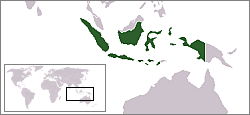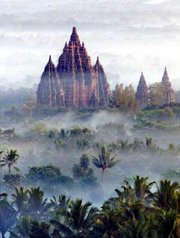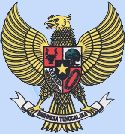Indonesia
|
|
The Republic of Indonesia is located in the Malay Archipelago, the world's largest archipelago, between Indochina and Australia, between the Indian and Pacific Oceans. It is the most populous Muslim-majority nation in the world and the fourth most populous overall. It has had free elections since the Indonesian 1998 Revolution toppled General Suharto, who seized power in 1965.
| |||||
| Motto: Bhinneka Tunggal Ika (Old Javanese/Kawi: Unity in Diversity) National ideology: Pancasila Indonesia | |||||
| Anthem: Indonesia Raya | |||||

| |||||
| Capital | Jakarta Template:Coor dm | ||||
| Largest city | Jakarta | ||||
| Official languages | Indonesian (Bahasa Indonesia / Indonesian Language) | ||||
| Government | Democratic republic Susilo Bambang Yudhoyono | ||||
| Independence - Declared - Recognised | From Netherlands August 17, 1945 December 27, 1949 | ||||
| Area • Total • Water (%) | 1,919,440 km² (15th) 4.85% | ||||
| Population • 2004 est. • — census • Density | 238,452,952 (4th) — 131/km² (—) | ||||
| GDP (PPP) • Total • Per capita | 2003 estimate $758.1 billion (15th) $3,200 (109th) | ||||
| Currency | Rupiah (IDR)
| ||||
| Time zone • Summer (DST) | various (UTC+7 to +9) not observed (UTC+7 to +9) | ||||
| Internet TLD | .id | ||||
| Calling code | +62
| ||||
| Contents |
History
Main article: History of Indonesia
Under the influence of Hinduism and Buddhism, several kingdoms formed on the islands of Sumatra and Java from the 7th to 14th century. The arrival of Arab traders from Gujarat, India later brought Islam, which became the dominant religion in many parts of the archipelago after the collapse of Hindu and Buddhist Kingdoms.
When the Europeans came in the early 16th century, they found a multitude of small states. These were vulnerable to the Europeans, who were in pursuit of dominating the spice trade. In the 17th century, the Dutch emerged as the most powerful of the Europeans, ousting the Spanish and Portuguese (except for their colony Portuguese Timor on the island of Timor). The Netherlands ruled Indonesia as a colony until World War II, first under the control of the Dutch East India Company (VOC), and then directly by the Dutch government beginning in the nineteenth century.
Under the nineteenth-century Cultivation System (Cultuurstelsel), large plantations and forced cultivation was established on Java, finally creating the profit for the Netherlands that the VOC was unable to produce. In a more liberal period of colonial rule after 1870 the Cultivation System was abolished, and after 1901 the Dutch introduced the Ethical Policy, which included limited political reform and increased investment in the colony.
During World War II, with The Netherlands under German occupation, Japan occupied the Dutch colony. Some of the Indonesian elite, and many of the future leaders of the Republic of Indonesia, cooperated with the Japanese occupiers, as they saw them as a welcome change after Dutch rule. In 1945, with the war drawing to a close, Japan sponsored a committee, led by Sukarno, to plan for independence. Sukarno declared independence on 17 August.
In an effort to regain control of their previously occupied colonies, the Allies sent in their armies, together with the Netherlands' Army. Indonesia's war for independence lasted from 1945 until 27 December 1949, when, under heavy international pressure, the Netherlands acknowledged Indonesia's independence. Sukarno became the country's first president, with Mohammad Hatta as the first vice president. See Indonesian National Revolution
The 1950s and 1960s saw Sukarno's government aligning itself first with the emerging non-aligned movement and later with the socialist bloc. The 1960s saw Indonesia in a military confrontation against neighboring Malaysia, and increasing frustration over domestic economic difficulties.
Army general Suharto became president in 1967 with the excuse of securing the country against an alleged Communist coup attempt against a weakening Sukarno. In the aftermath of Suharto's rise, hundreds of thousands people were killed or imprisoned in a backlash against alleged Communist supporters. Suharto's administration is commonly called the New Order era. Suharto invited major foreign investment into the country, which produced substantial, if uneven, economic growth. However, Suharto enriched himself and his family through widespread corruption and he was forced to step down amid massive popular demonstrations and a faltering economy in 1998. See Indonesian 1998 Revolution.
In the period of 1998 to 2001, the country had three presidents: Bacharuddin Jusuf (BJ) Habibie, Abdurrahman Wahid and Megawati Sukarnoputri. In 2004, the largest one-day election in the world and Indonesia's first direct Presidential election was held and was won by Susilo Bambang Yudhoyono.
Parts of northern Sumatra, particularly Aceh, were devastated by a massive earthquake and tsunami on 26 December 2004. See Impact of the 2004 Indian Ocean earthquake on Indonesia.
Politics
Main article: Politics of Indonesia
The highest legislative body is the Majelis Permusyawaratan Rakyat (MPR, head: Hidayat Nur Wahid) or 'People's Consultative Assembly', consisting of the Dewan Perwakilan Rakyat (DPR, head: Agung Laksono) or Peoples Representative Council, elected for a five-year term, and the Dewan Perwakilan Daerah (DPD, head: Ginandjar Kartasasmita) or Regional Representatives Council. Following elections in 2004, the MPR became a bicameral parliament, with the creation of the DPD as its second chamber.
Provinces
Main article: Provinces of Indonesia
Currently, Indonesia has 33 provinces (of those, 2 are special territories and 1 capital city territory). The provinces are subdivided in districts, which are in turn split up in sub-districts and municipalities. The provinces are:
Bali, Bangka-Belitung, Banten, Bengkulu, Central Java, Central Kalimantan, Central Sulawesi, East Java, East Kalimantan, East Nusa Tenggara, South Sumatra, Gorontalo, Jambi, Lampung, Maluku, North Maluku, North Sulawesi, North Sumatra, Papua (Irian Jaya), Riau, Riau Kepulauan, South East Sulawesi, South Kalimantan, South Sulawesi, West Irian Jaya, West Java, West Kalimantan, West Nusa Tenggara, West Sulawesi, West Sumatra
The special territories (daerah istimewa) are Aceh (or Nanggroe Aceh Darussalam) and Yogyakarta. The capital city territory is Jakarta.
East Timor was a province of Indonesia from its annexation in 1976 until Indonesia relinquished sovereignty in 1999. Following a period of transitional administration by the UN, it became an independent state in 2002.
Geography
Main article: Geography of Indonesia
Id-map.png
Indonesia's 18,108 islands, of which about 6,000 are inhabited, are scattered around the equator, giving the country a tropical climate. The largest populated islands are Java, where about half of the population lives, Sumatra, Borneo (shared with Malaysia and Brunei), New Guinea (shared with Papua New Guinea) and Sulawesi. The country borders Malaysia on the island of Borneo (Indonesian: Kalimantan), Papua New Guinea on the island of New Guinea and East Timor on the island of Timor. In addition to the capital city of Jakarta, principal Indonesian cities of high population include Surabaya, Bandung, Medan, Palembang, and Semarang.
Its location on the edges of tectonic plates means Indonesia is frequently hit by earthquakes and the resulting tsunamis. Indonesia is also rich in volcanoes, the most famous being the now vanished Krakatau (Krakatoa), which was located between Sumatra and Java.
Flora and fauna differ markedly between Kalimantan, Bali, and western islands on the one hand and Sulawesi, Lombok, and islands further to the east on the other hand. This ecological boundary has been called the Wallace line after its discoverer. The line is often given as the boundary between Asia and Australasia, as such making Indonesia a bicontinental country.
See also: Map of Asia
Economy
Main article: Economy of Indonesia
Indonesia's economy suffered greatly in the late 1990s, in part as a result of the financial crisis that struck most of Asia at the time. The economy has stabilized somewhat since then.
The country has extensive natural resources outside of Java, including crude oil, natural gas, tin, copper and gold. Indonesia is the world's second largest exporter of natural gas, though it has recently become a net importer of crude oil. Major agricultural products include rice, tea, coffee, spices and rubber.
Indonesia's major trading partners are Japan, the United States and the surrounding nations of Singapore, Malaysia and Australia.
The central bank of Indonesia is Bank Indonesia [1] (http://www.bi.go.id)
Demographics
Main article: Demographics of Indonesia
Indonesia's population can be roughly divided into two groups. In the west of the country, the people are mostly Malay, while the people of the east are Papuan, with roots in the islands of Melanesia. Many Indonesians identify with a more specific ethnic group that is often linked to language and regional origins; examples of these are Javanese, Sundanese, or Batak.
Islam is Indonesia's main religion, with almost 89%(88.22%) of all Indonesian adhering to it according to the 2000 religious census, making Indonesia the most populous Muslim-majority nation in the world. The remainder of the population is Christian (9%), Buddhist (2%), and Hindu (7%).

Most Indonesians speak a local language (bahasa daerah) as their first tongue, but the official national language, Indonesian (also called bahasa Indonesia, and closely related to Malay) is almost universally taught in schools and is spoken by nearly every Indonesian.
Culture
Main article: Culture of Indonesia
Art forms in Indonesia have been influenced by several cultures. The famous Javanese and Balinese dances, for example, contain aspects of Hindu culture and mythology.
Also well-known are the Javanese and Balinese wayang kulit shadow theatre shows, displaying several mythological events. Several islands are famous for their batik and ikat cloth.
Silat is a unique martial art originating from the archipelago.
Miscellaneous topics
- Communications in Indonesia
- Transportation in Indonesia
- Islands of Indonesia
- Military of Indonesia
- Music of Indonesia
- Foreign relations of Indonesia
- List of famous Indonesians
- Hinduism in Southeast Asia
- Indonesian car number plates
- Islam in Indonesia
- Public holidays in Indonesia
- Indonesian calendars
- Indonesian Chinese


